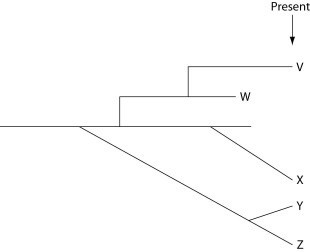Multiple Choice
The next few questions refer to the following evolutionary tree, whose horizontal axis represents time (present time is on the far right) and whose vertical axis represents morphological change.

-Which of these five species is the extant (i.e., not extinct) species that is most closely related to species X, and why is this so?
A) V; shared a common ancestor with X most recently
B) W; shared a common ancestor with X most recently
C) Y; arose in the same fashion (i.e., at the same tempo) as X
D) Z; shared a common ancestor with X most recently, and arose in the same fashion as X
E) This tree does not provide enough information to answer this question.
Correct Answer:

Verified
Correct Answer:
Verified
Q24: Bird guides once listed the myrtle warbler
Q25: The phenomenon of fusion is likely to
Q26: Theoretically, the production of sterile mules by
Q27: The most likely explanation for the recent
Q28: There is still some controversy among biologists
Q30: The next few questions refer to the
Q31: What is the best way to promote
Q32: Two closely related populations of mice have
Q33: Rocky Mountain juniper (Juniperus scopulorum)and one-seeded juniper
Q34: The next few questions refer to the